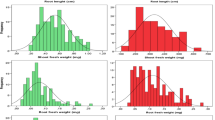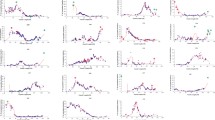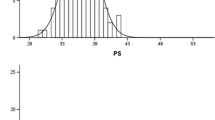Abstract
A significant level of root elongation was induced in rice (Oryza sativa) grown under phosphorus-deficient conditions. The root elongation clearly varied among a total of 62 varieties screened under two different phosphorus levels. Two contrasting varieties, ‘Gimbozu’, with a low elongating response and ‘Kasalath’, with a high elongating response, were chosen and crossed to produce a hybrid population for QTL analyses. QTLs for the phosphorus deficiency-induced root elongation were detected by two linkage maps, i.e., one with 82 F3 families constructed by 97 simple sequence repeat (SSR) and sequence-tag site markers and another with 97 F8 lines by 790 amplified fragment length polymorphism and SSR markers. A single QTL for the elongation response was detected on chromosome 6, with a LOD score of 4.5 in both maps and explained about 20% of total phenotypic variance. In addition, this QTL itself, or a region tightly linked with it, partly explained an ability to reduce accumulation of excess iron in the shoots. The identified QTL will be useful to improve rice varieties against a complex nutritional disorder caused by phosphorus deficiency and iron toxicity.






Similar content being viewed by others
References
Anuradha M, Narayanan A (1991) Promotion of root elongation by phosphorus deficiency. Plant Soil 136:273–275
Basten CJ, Weir BS, Zeng ZB (1994) Zmap-a QTL cartographer. In: Smith C, Gavora JS, Benkel B, Chesnais J, Fairfull W, Gibson JP, Kennedy BW, Burnside EB (eds) Proceedings of the 5th World Congress on Genetics Applied to Livestock Production: computing strategies and software, vol 22. The Organizing Committee, 5th World Congress on Genetics Applied to Livestock Production, Ontario, pp 65–66
Borch K, Bouma TJ, Lynch JP, Brown KM (1999) Ethylene: a regulator of root architectural responses to soil phosphorus availability. Plant Cell Environ 22:425–431
Chen X, Temnykh S, Xu Y, Cho YG, McCouch SR (1997) Development of a microsatellite framework map providing genome-wide coverage in rice (Oryza sativa L.). Theor Appl Genet 95:553–567
Churchill GA, Doerge RW (1994) Empirical threshold values for quantitative trait mapping. Genetics 138:963–971
Feng Q, et al (2002) Sequence and analysis of the rice chromosome 4. Nature 420:316–320
Gaume A, Mächler F, De León C, Narro L, Frossard E (2001) Low-P tolerance by maize (Zea mays L.) genotypes: significance of root growth, and organic acids and acid phosphatase root exudation. Plant Soil 228:253–264
Gomez KA, Gomez AA (1984) Statistical procedures for agricultural research, 2nd edn. Wiley, New York
Hayashi T, Ukai Y (1999) Method of QTL mapping in an F2 population using phenotypic means of F3 lines. Breed Sci 49:105–114
He Y, Lian H, Yan X (2003) Localized supply of phosphorus induces root morphological and architectural changes of rice in split and stratified soil cultures. Plant Soil 248:247–256
Jiang C, Zeng ZB (1995) Multiple trait analysis of genetic mapping for quantitative trait loci. Genetics 140:1111–1127
Kawasaki S, Murakami Y, Imaizumi-Anraku H, Shimizu A, Mikami I (2003) Construction of high-density map, genome library, and saturation mapping of nodulation genes. In: Nagata T, Tabata S (eds) Biotechnology in agriculture and forestry, vol 52. Springer, Berlin Heidelberg New York, pp 183–202
Kirk GJD, Du LV (1997) Changes in rice root architecture, porosity, and oxygen and proton release under phosphorus deficiency. New Phytol 135:191–200
Lander ES, Green P, Abrahamson J, Barow A, Daly MJ, Lincoln SE, Newbug L (1987) MAPMAKER: an interactive computer package for constructing primary genetic linkage maps of experimental and natural populations. Genomics 1:174–181
Lópes-Bucio J, Cruz-Ramírez A, Herrera-Estrella L (2003) The role of nutrient availability in regulating root architecture. Curr Opin Plant Biol 6:280–287
Lynch J (1995) Root architecture and plant productivity. Plant Physiol 109:7–13
Ma Z, Baskin TI, Brown KM, Lynch JP (2003) Regulation of root elongation under phosphorus stress involves changes in ethylene responsiveness. Plant Physiol 131:1381–1390
Maclean JL, Dawe DC, Hardy B, Hettel GP (2002) Rice almanac, 3rd edn. IRRI, Manila
Ni JJ, Wu P, Senadhira D, Huang N (1998) Mapping QTLs for phosphorus deficiency tolerance in rice (Oryza sativa L.) Theor Appl Genet 97:1361–1369
Ottow JCG, Benckiser G, Watanabe I (1983) Is iron toxicity of rice the result of a multiple nutritional stress? Plant Res Dev 17:96–109
Raghothama KG (1999) Phosphate acquisition. Annu Rev Plant Physiol Plant Mol Biol 50:665–693
Rausch C, Bucher M (2002) Molecular mechanisms of phosphate transport in plants. Planta 216:23–37
Robeniol JA, Constantino SV, Resurreccion AP, Villareal CP, Ghareyazie B, Lu BR, Katiyar SK, Menguito CA, Angeles ER, Fu HY, Reddy S, Park W, McCouch SR, Khush GS, Bennett J (1996) Sequence-tagged sites and low-cost DNA markers for rice. In: Rice genetics 3. IRRI, Manila, pp 293–306
Sasaki T et al (2002) The genome sequence and structure of rice chromosome 1. Nature 420:312–316
Steingrobe B, Schmid H, Claassen N (2001) Root production and root mortality of winter barley and its implication with regard to phosphate acquisition. Plant Soil 237:239–248
Vos P, Hogers R, Bleeker M, Reijans M, van de Lee T, Hornes M, Frijters A, Pot J, Peleman J, Kuiper M, Zabeau M (1995) AFLP: a new technique for DNA fingerprinting. Nucleic Acids Res 23:4407–4414
Wissuwa M, Yano M, Ae N (1998) Mapping of QTLs for phosphorus-deficiency tolerance in rice (Oryza sativa L.). Theor Appl Genet 97:777–783
Yoshida S, Forno DA, Cock JH, Gomez KA (1976) Laboratory manual for physiological studies of rice, 3rd edn. IRRI, Manila
Zar JH (1996) Biostatistical analysis, 4th edn. Prentice Hall, Upper Saddle River
Zeng Z (1994) Precision mapping of quantitative trait loci. Genetics 196:1457–1468
Acknowledgements
This research was funded by the Japan-IRRI Shuttle Research Project.
Author information
Authors and Affiliations
Corresponding author
Additional information
Communicated by Q. Zhang
Electronic Supplementary Material
Rights and permissions
About this article
Cite this article
Shimizu, A., Yanagihara, S., Kawasaki, S. et al. Phosphorus deficiency-induced root elongation and its QTL in rice (Oryza sativa L.). Theor Appl Genet 109, 1361–1368 (2004). https://doi.org/10.1007/s00122-004-1751-4
Received:
Accepted:
Published:
Issue Date:
DOI: https://doi.org/10.1007/s00122-004-1751-4




